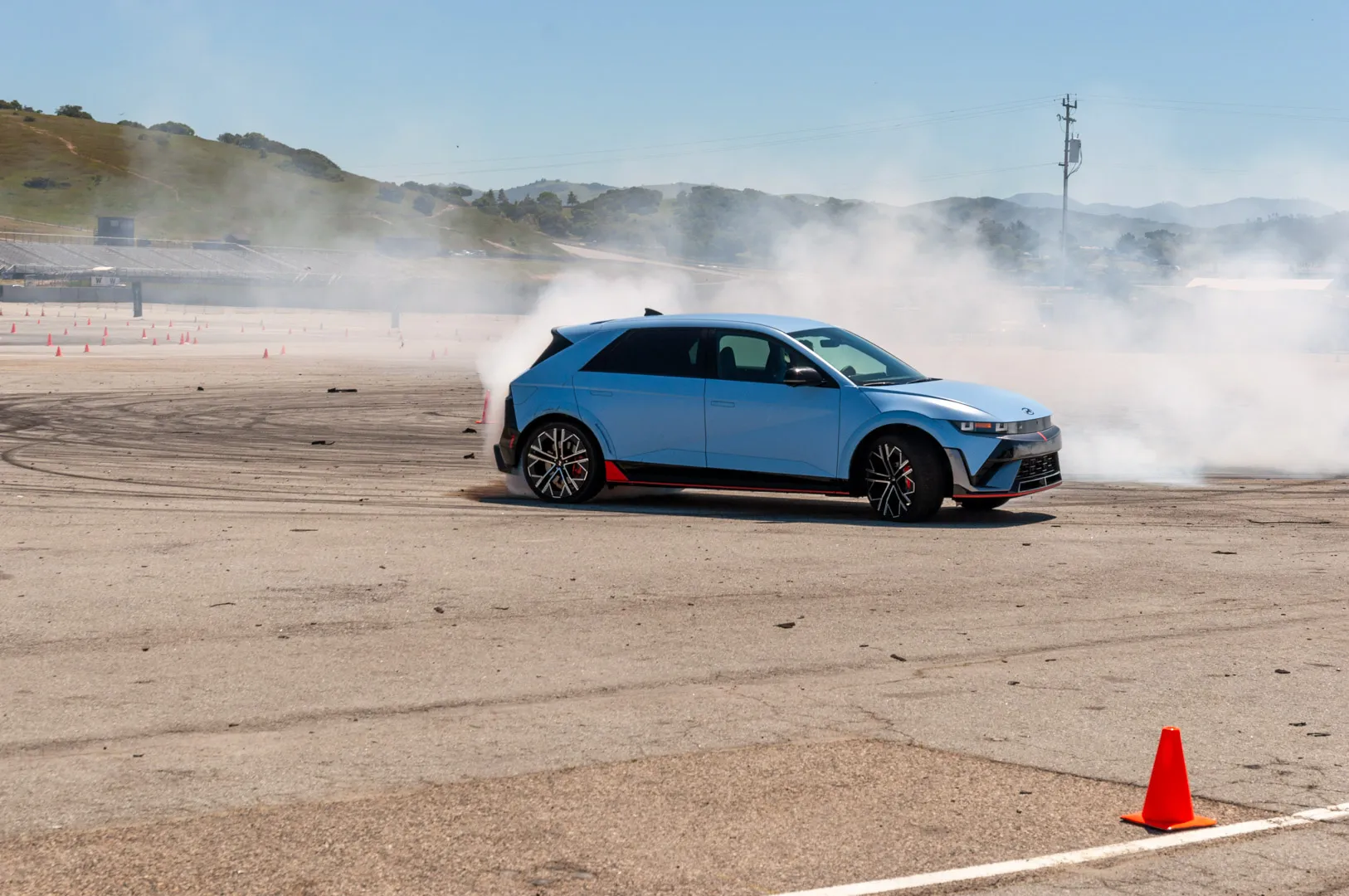Clutching your pearls because you’re scared the automotive future is boring is a bunch of meshugas.
I know this because I screamed around Laguna Seca last week in the 2025 Hyundai Ioniq 5 N, shifting via paddles and hitting the rev limiter.
As the 2025 Hyundai Ioniq 5 N rolls into dealerships for $67,475, including a $1,375 destination charge, consumers are going to find an electric sports car unlike any other EV on sale today.
This is how you build a bridge into the future for skeptics and enthusiasts alike. Thankfully, you can disable the bridge for those moments the silliness isn’t appreciated.
2025 Hyundai Ioniq 5 N
Hyundai Ioniq 5 N shifts, snaps, crackles, and pops
We’d have three sessions the Hyundai team said as we walked to the cars “idling” in the pits at Laguna Seca. For the first session we would run in N mode with e-Shift set to “automatic.” Hyundai said the powertrain’s e-Shift software had been programmed to feel like a gas-powered car with an 8-speed dual-clutch automatic transmission. This programming includes simulated shifts, right down to the torque curves, and the associated jolts to your body with the interruptions in power flow.
Pulling onto the track, the Ioniq 5 N’s powertrain growled through the speakers, doing a shocking impression of what I would hear in an Elantra N. The snaps, crackles, and pops were all there as the powertrain digitally revved with a max output of 85 decibels. For reference, an Elantra N at full tilt checks in at 100 decibels. It all sounded convincingly natural. That’s because it’s been programmed to use speakers placed under the hood, underneath the car on the rear passenger side, and inside the cabin. The sound programming uses all the speakers and places the correct tones in the right places within and outside the vehicle. The “exhaust” note comes from the back of the vehicle both inside and out, the “engine” noise comes from underneath the hood and the front of the vehicle, and the various other noises come from around the cabin. It all sounds reasonably natural in the Ignition mode. The Evolution setting sounds futuristic with a higher pitch that replaces the snaps, crackles, and pops with more of a jet wind-up noise. Then there’s the Supersonic soundtrack that sounds like you’re headed into warp speed in the starship Enterprise before it unleashes a massive “boom” through speakers when the car “shifts” at redline. I couldn’t help but laugh at the silliness of the boom, which I could actually feel from the woofers.
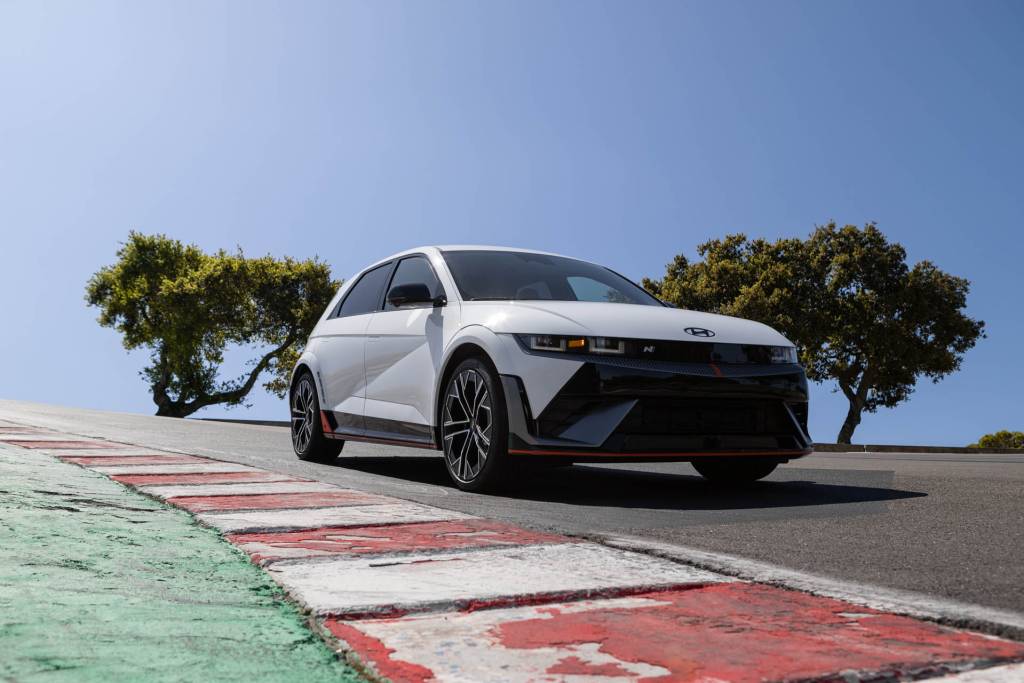
2025 Hyundai Ioniq 5 N
In a left into turn 2, known as the Andretti Hairpin, the car executed a hard downshift that my entire body felt as the virtual revs climbed and power built as it would if a gas engine were under the hood. Wild. Squeezing the accelerator pedal as I crossed the corner’s apex sent power to all four wheels while pushing and pulling the car around the corner. “Shockingly neutral,” I blurted out loud to no one as I started giggling.
Hyundai said every piece of the Ioniq 5 N’s suspension has been changed from the standard car, including but not limited to, stiffer components and larger adaptive dampers at each corner that have a wider range of adjustability. The entire structure’s been reinforced thanks to 42 additional weld points and an extra 6.9 feet of structural adhesives. The result is an 11% increase in stiffness.
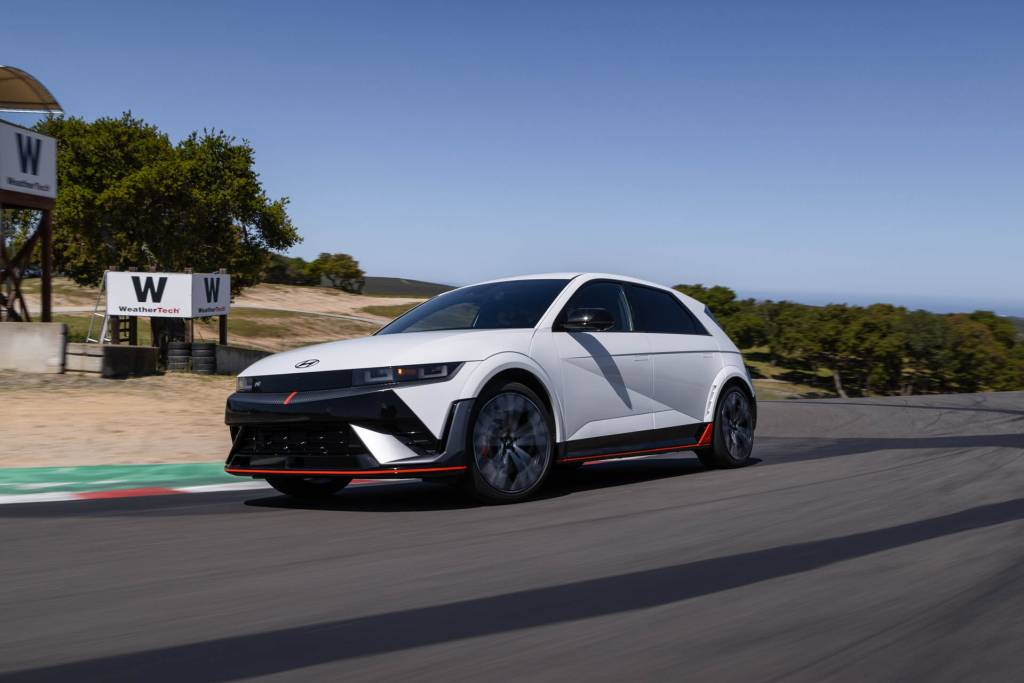
2025 Hyundai Ioniq 5 N
Linking the next nine corners together, including the infamous corkscrew, confirmed my initial impression that the handling is neutral. The weight is also well balanced and it sits low thanks to the 88.4-kwh battery pack located beneath the cabin. The car rotates with ease. As I came around turn 11 I hit the brakes and swung the rear end out, but the car didn’t lose composure. As the rear end kicked to the right and I countersteered and squeezed the throttle, the car quickly corrected the slide and shot forward.
Shifts came fast and furious as the powertrain banged through its virtual first, second, and third gears with power building progressively and quickly through each. Heading down the front straight, the overgrown hatchback hit 112 mph as I crested the hill at turn 1. The car lifted, perhaps even fully off the ground, the suspension dropped, and the steering went light. The car came down to earth and for the first time I was keenly aware of the car’s 4,861-pound curb weight. That’s 813 pounds more than a Tesla Model 3 Performance and 1,565 pounds more than an Elantra N.
In Turn 2, the Andretti Hairpin, I took the racing line, and I could feel the electronically controlled limited-slip rear differential shift power side to side to rotate the car through the corner. Seemingly nothing really upset this thing. Time to mess around.
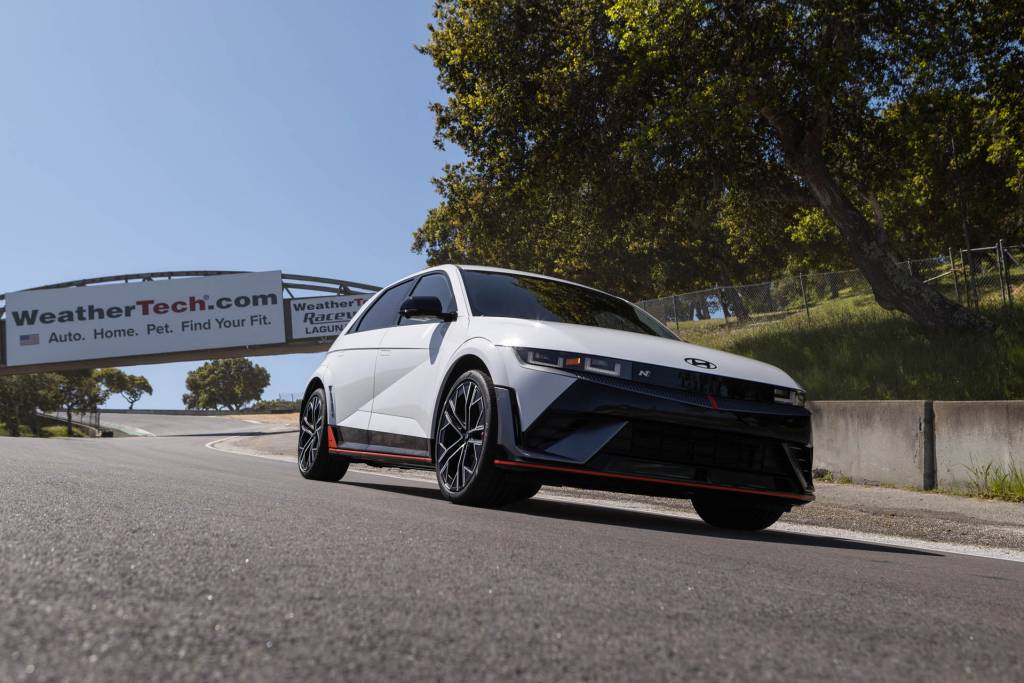
2025 Hyundai Ioniq 5 N
As I approached the corkscrew, I purposely went off the racing line, which put me too far inside for turn 8A immediately after. The Ioniq 5 N didn’t care that I ran over the inside curb as I nearly pushed to the runoff heading toward turn 9. The front Pirelli P Zero Elect tires, which Hyundai worked with Pirelli for more two years to develop for this car, gripped the pavement and flung me forward as I steered where I wanted to go and the rear sorted itself out.
Back to turn 11. I wasn’t quite as sideways as I was the first time, but the tail was still out. It quickly recovered and I blasted down the front straight hitting 121 mph as the car crested the top of turn 1. Everything went light again and when it came back down I immediately hit the brakes hard. The front dove and the rear end wiggled, but then figured itself out without ever feeling unstable. The car has up to 1.6 g of brake force, with up to 0.6 g of regen baked into that. The force comes from 4-piston monobloc calipers clamping 15.7-inch rotors up front and single-piston units grabbing 14.2-inch rotors in the back. That’s more regen capability than a Rimac Nevera or Porsche Taycan Turbo, which each goes up to 0.4 g. I couldn’t tell where the friction brakes started and the regen stopped. It all felt natural both on the track and street, and surprisingly the brakes never smoked during our track use.
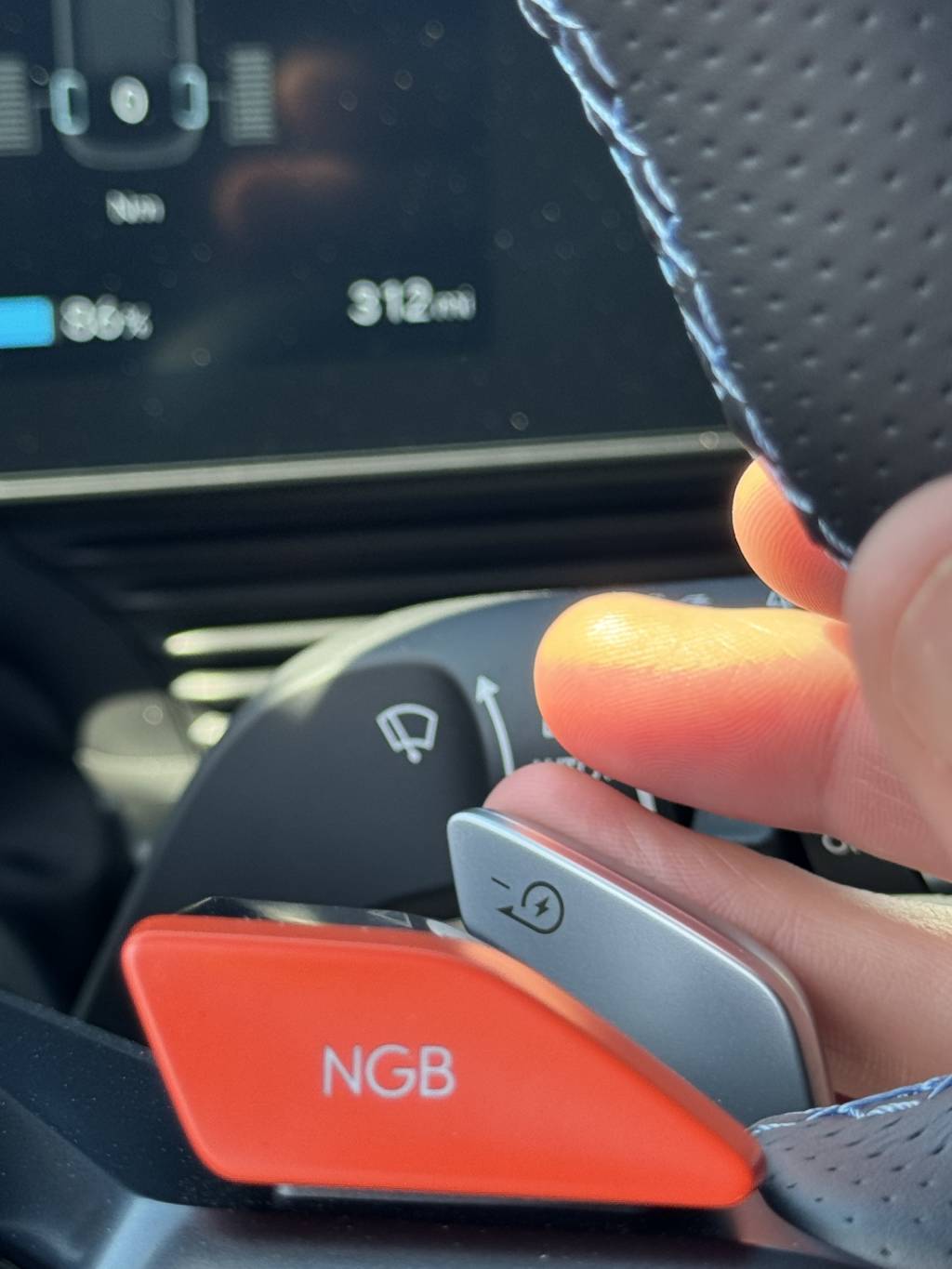
2025 Hyundai Ioniq 5 N
Hyundai Ioniq 5 N can be manually shifted
The Hyundai crew told me for the next lap session we were going to use the wheel-mounted shift paddles in the e-Shift feature’s manual mode. As I pulled onto the track, the gauge cluster showed green, then orange, and then quickly red bands around the tachometer indicating I needed to shift as if I were in a BMW M car. Suddenly, the car lurched and hit a power wall because I had maxed out first gear. Things move quickly with a 0-60 mph time of 3.25 seconds. Clicking the right paddle instantly shifted to second gear and the car surged forward. I shifted to third, and then two clicks of the left paddle back down to first entering Andretti corner.
On the first of four laps, I soon realized the car was slower around the track with the manual shifts than it was in full auto mode. I never ran the track without the e-Shift engaged, manual or auto, so I can’t comment how the car feels on the track without it.
On the twisty back roads of Carmel Valley the paddle shifters and natural power bands added to the driving experience. But it felt weird to be driving an electric car that was doing its best to mimic a gas-powered car. The manual shifts make things slower on the track, but you can only go so fast on the street, so they can add to the fun. Shifting manually in traffic would make no sense, but on a twisty back road it’s entertaining.
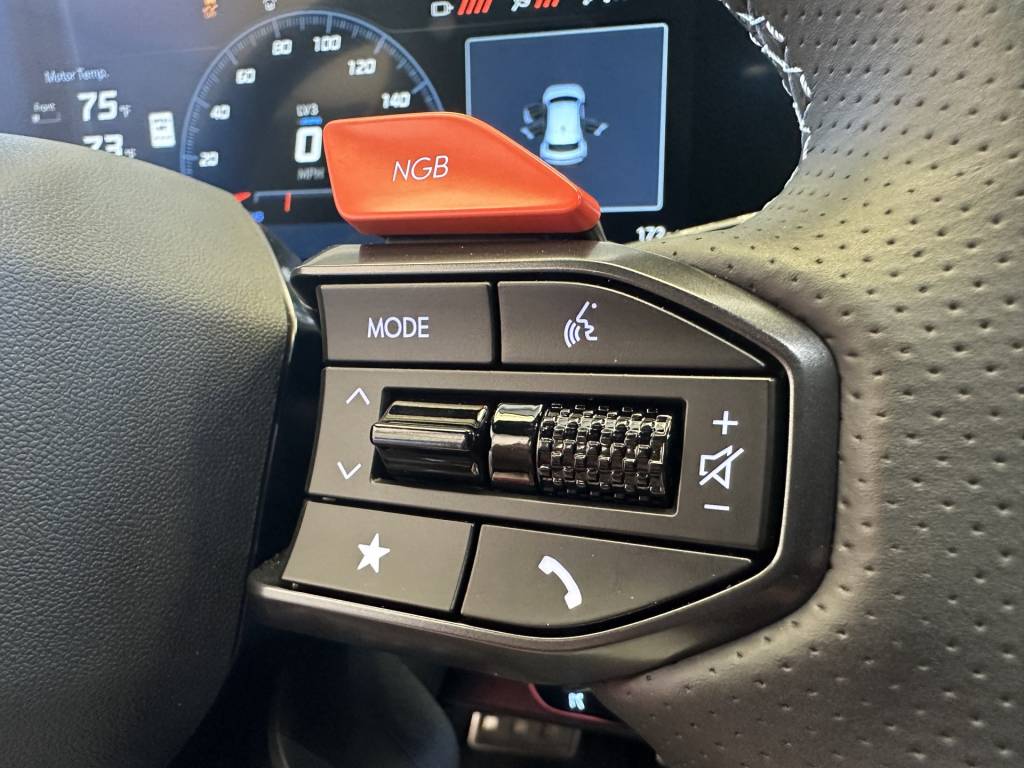
2025 Hyundai Ioniq 5 N – Emme Hall
Hyundai Ioniq 5 N’s overboost is overblown
For the third session we were told to use the N Grin Boost button, which is a red button on the right side of the steering wheel. Pushing it delivers a 40 hp boost for up to 10 seconds, then it needs another 10 seconds to recover.
As I came out of turn 11 heading down the front straight I hit N Grin Boost. A circular countdown appeared on the top right of the 12.3-inch digital gauge cluster: 10 … 9 … 8 … 7 … my boost was already running out. Did it even work? I didn’t feel anything.
With 601 hp and 545 lb-ft of torque (N Grin Boost doesn’t change torque output), an extra 40 hp didn’t deliver a kick in the pants. I waited and saved my boost for an uphill portion to see if I could feel it more. After turn 6 heading up Rahal Straight I hit the red button, the counter appeared, and … nothing. I didn’t feel a surge of power. Between the car’s weight and only 40 extra hp, the N Grin Boost button kind of feels like a gimmick. It’s just not enough power to notice.

2025 Hyundai Ioniq 5 N
Hyundai Ioniq 5 N tuned to handle track days
The team at Hyundai gave the Ioniq 5 N a larger 84.0-kwh battery pack versus the standard Ioniq 5’s 77.4-kwh pack. The pack’s footprint didn’t change, but the energy density and cell chemistry changed to increase the amount of energy in the pack and sustain higher thermal loads.
The car’s cooling system has been upgraded with a new front-end design featuring more airflow, two larger radiators (one low temp and one high temp), and the ability to use the air conditioning to help cool the powertrain.
These changes allow the Ioniq 5 N to run two full laps of the Nürburgring at full tilt without the powertrain derating its power. A Hyundai spokesperson told Motor Authority the car could probably run three to four laps on the ‘Ring if not going at full tilt.
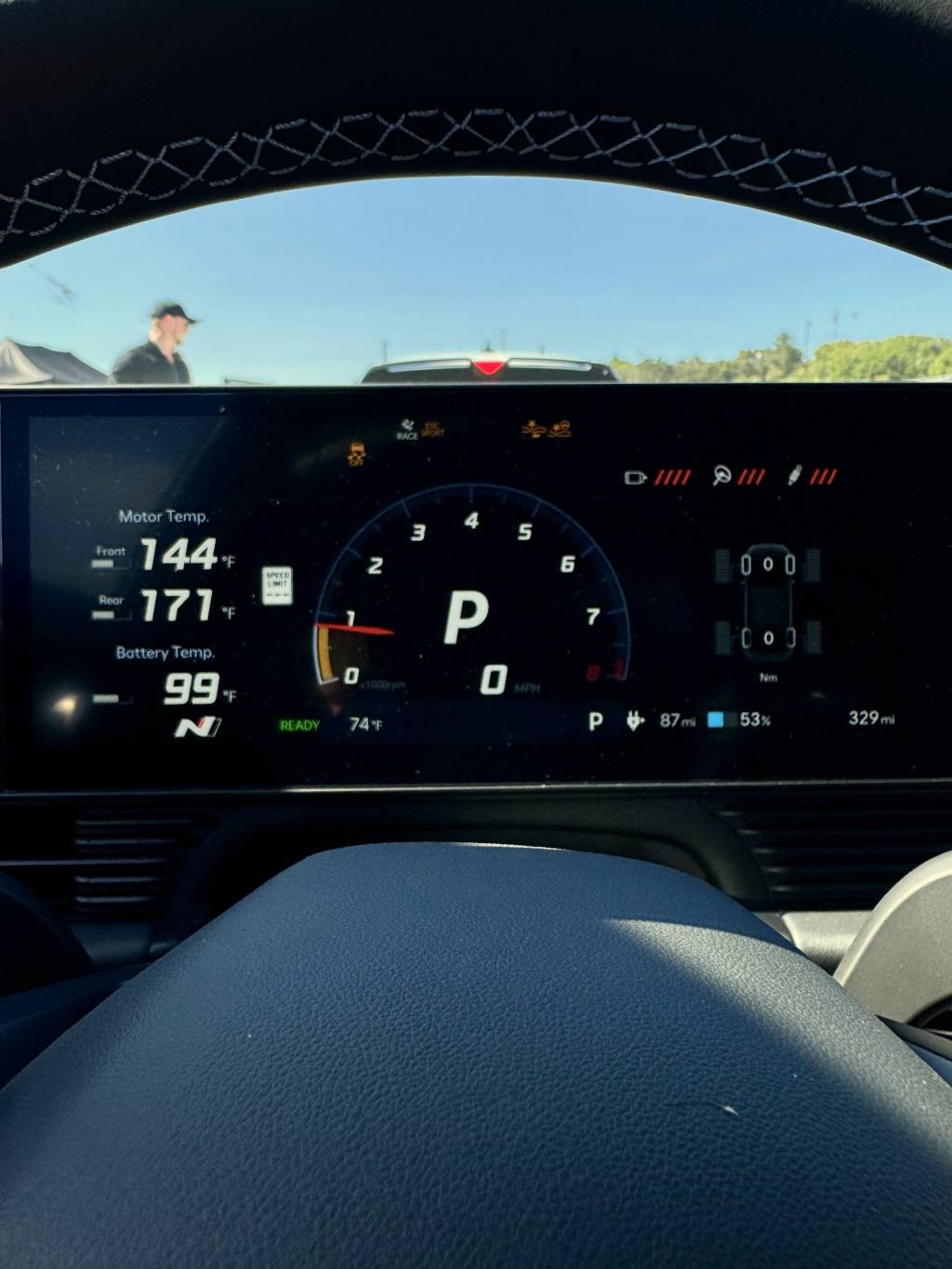
2025 Hyundai Ioniq 5 N
My first four laps around Laguna Seca used 11% of the battery, my second four laps used another 15% and my final four laps used 19% of the battery. After 12 laps the battery had a 53% state of charge, and I started with 98%. Motor temperatures never crested 144 degrees for the front motor and 171 degrees for the rear, while the battery temp never went above 99 degrees.
Hyundai said the Ioniq 5 N is capable of a peak charging rate of about 235 kw. This means it can still charge from 10-80% in 18 minutes. That’s handy because it only has 221 miles of range, and much less on a racetrack where it will need to be charged more often and at a slower pace because it won’t be optimized. Hyundai’s in talks with racetracks about installing dedicated fast chargers so Ioniq 5 Ns can charge between sessions during track days.
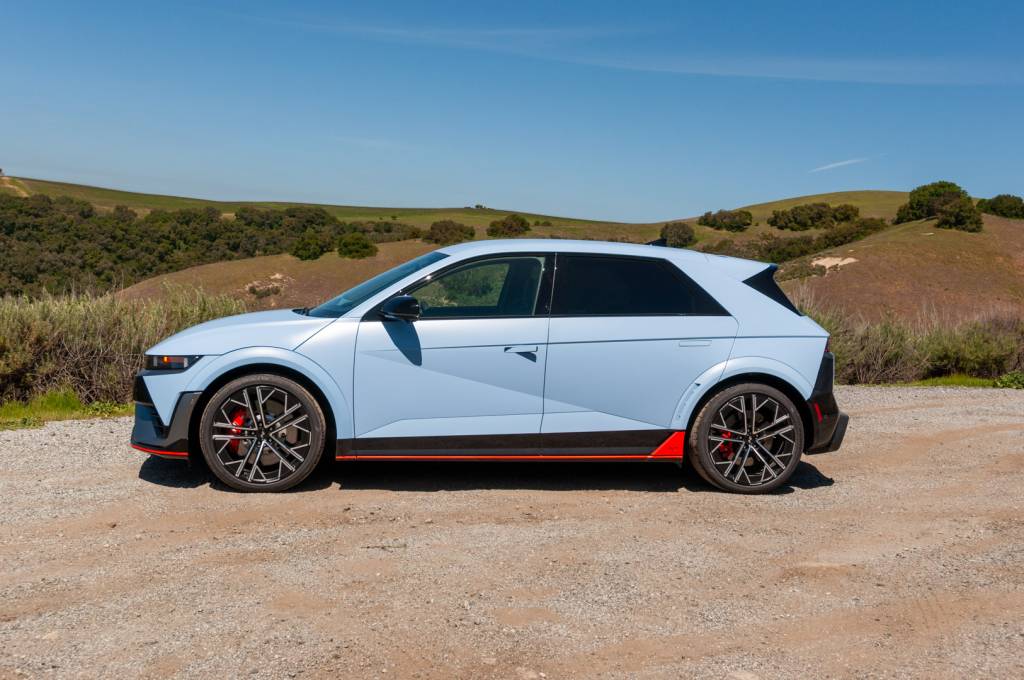
2025 Hyundai Ioniq 5 N
Hyundai 5 N looks like a hot hatch
Hyundai calls the Ioniq 5 N a crossover SUV, but it sits lower to the ground with ground clearance checking in at a car-like 5.6 inches versus the standard car’s 6.1 inches. It’s 2.0 inches wider than the standard Ioniq 5 thanks to flared fenders to fit the wider 275/32R21 tires at all four corners mounted on forged wheels. With a front splitter, a rear wing, and a rear diffuser, this doesn’t look like a standard Ioniq 5, but it doesn’t have a boy racer look like the Honda Civic Type R with its massive rear wing. Let’s face it, though, it’s a hot hatch, not a crossover.
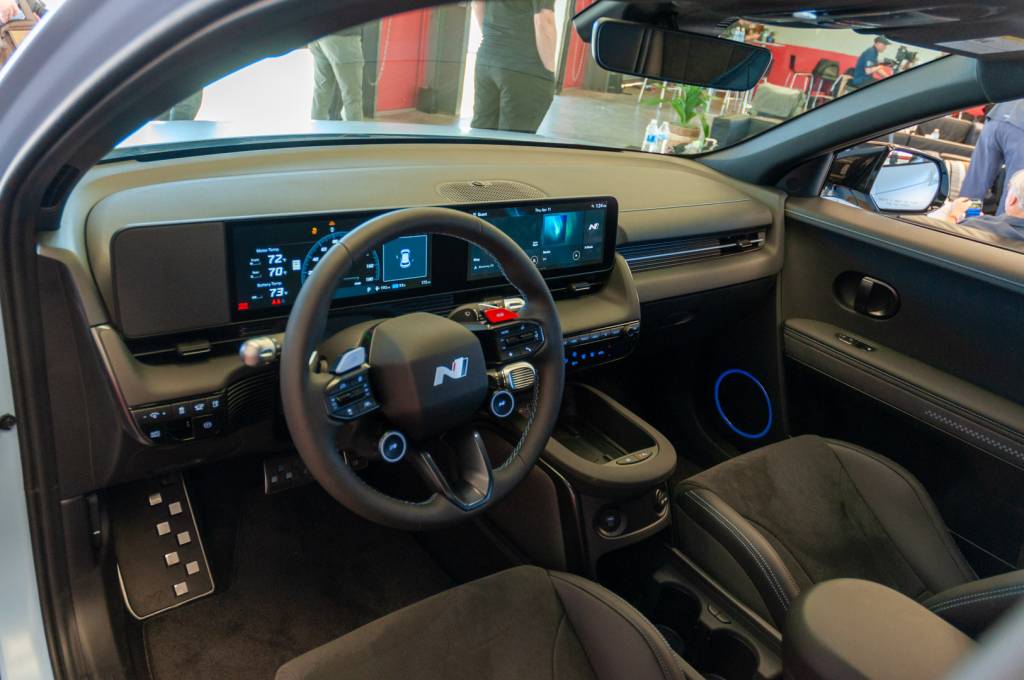
2025 Hyundai Ioniq 5 N
Inside, the Ioniq 5’s 12.3-inch digital gauge cluster and 12.3-inch touchscreen carry over, as does the dashboard. But the open console area has been replaced by a center console that comes out from the dash. Its sides are padded to protect your knees during hard cornering. The cabin feels less open, but also more traditional. N sport bucket seats hug the body up front but aren’t terribly constricting. Like the standard car, the driver has a knees-up seating position due to the battery pack in the floor. Metal pedal and footrest covers are decorated with a race flag design. Hyundai’s trademark N blue color is splashed all over the cabin from the stitching to the lighting.
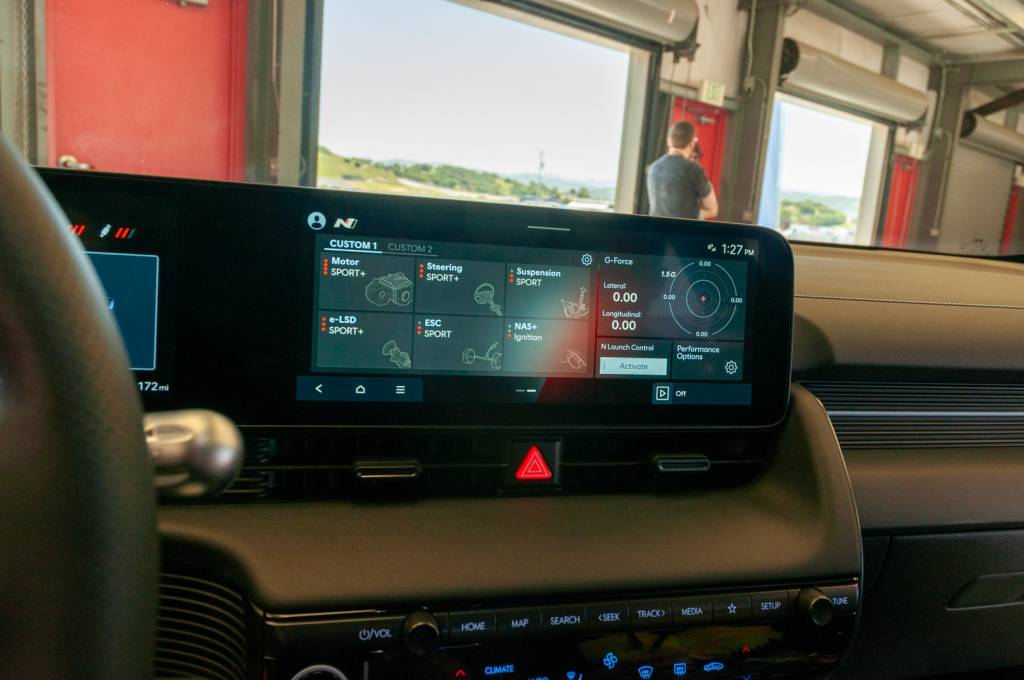
2025 Hyundai Ioniq 5 N
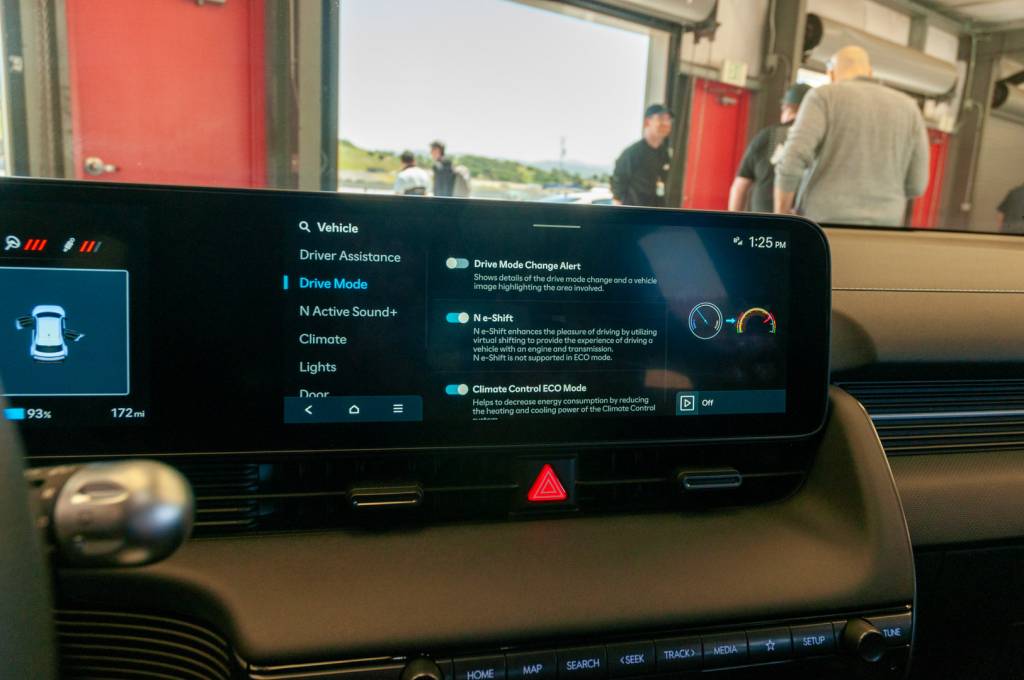
2025 Hyundai Ioniq 5 N
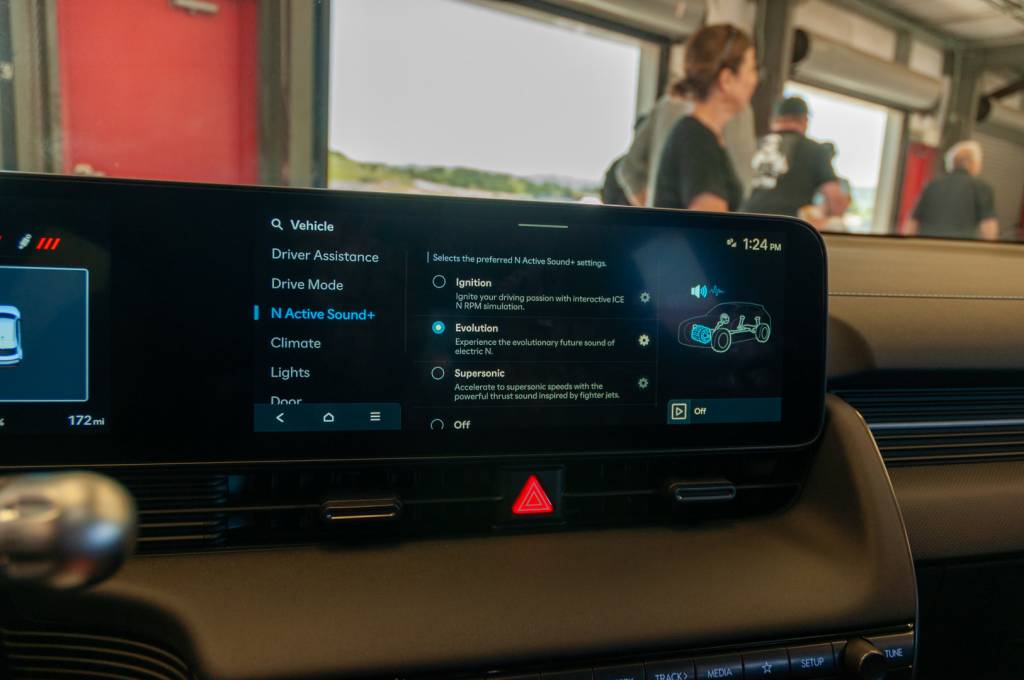
2025 Hyundai Ioniq 5 N
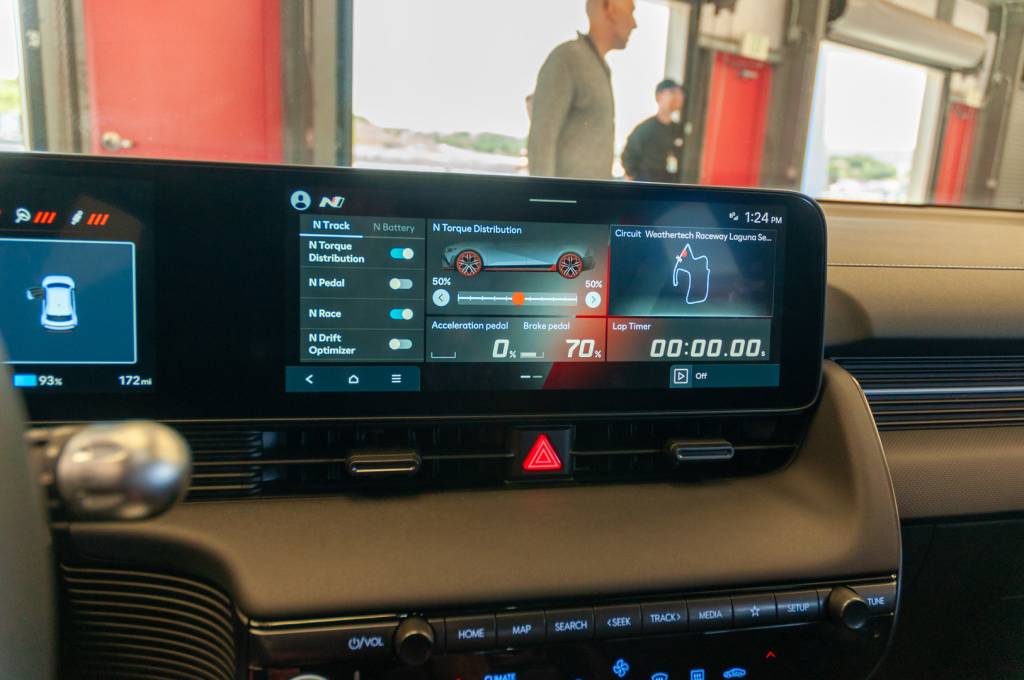
2025 Hyundai Ioniq 5 N
Hyundai 5 N overwhelms with customization
Ioniq 5 N owners will be able to choose their own adventure thanks to numerous settings. The menu system is vast, from various stages of steering boost, suspension firmness, and steering weight, three different (for now) sound generator choices, volume choices for that sound generator, driving modes, and more. It would take quite some time to determine the Goldie Locks settings for various situations. Hitting N mode just cranks everything to the max, including the sound output.
This is before addressing the torque distribution, which can favor the front or rear for some wild rear-wheel-drive burnouts. There’s even a drift mode.
The simulated shifts and manual shifts with e-Shift, along with the active sound generator, can be turned off for those who think an EV shouldn’t impersonate a gas-powered car. It won’t be easy, though, as it’ll take at least one swipe and three taps, minimum, within the infotainment system.
For everyone else, Hyundai has proven an electric sports car can be fast, fun, engaging, and visceral, as well as interactive. None of this may be necessary, but it shows fun won’t die with the shift to electric cars.
Hyundai paid for travel and lodging for Motor Authority to bring you this firsthand report.

